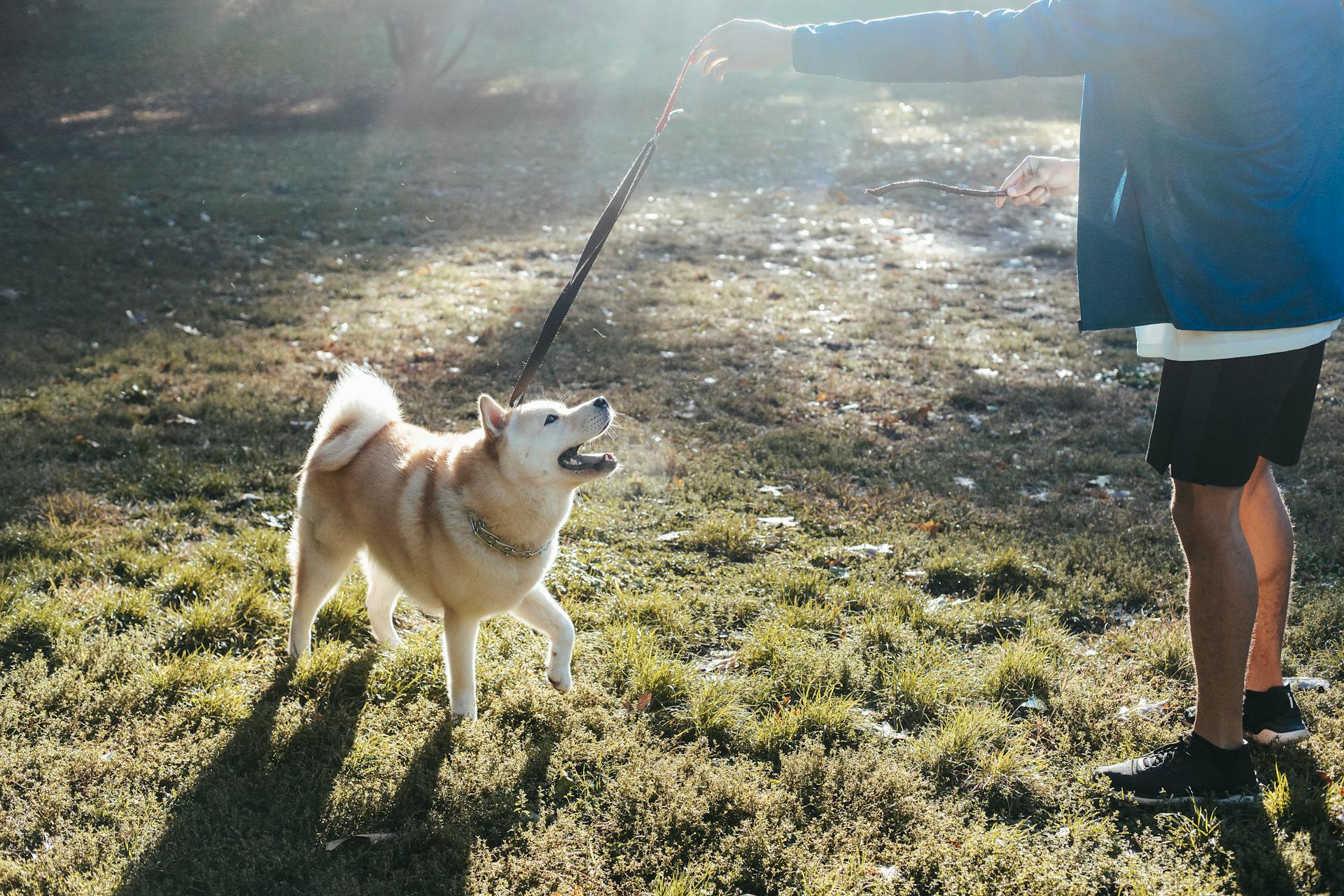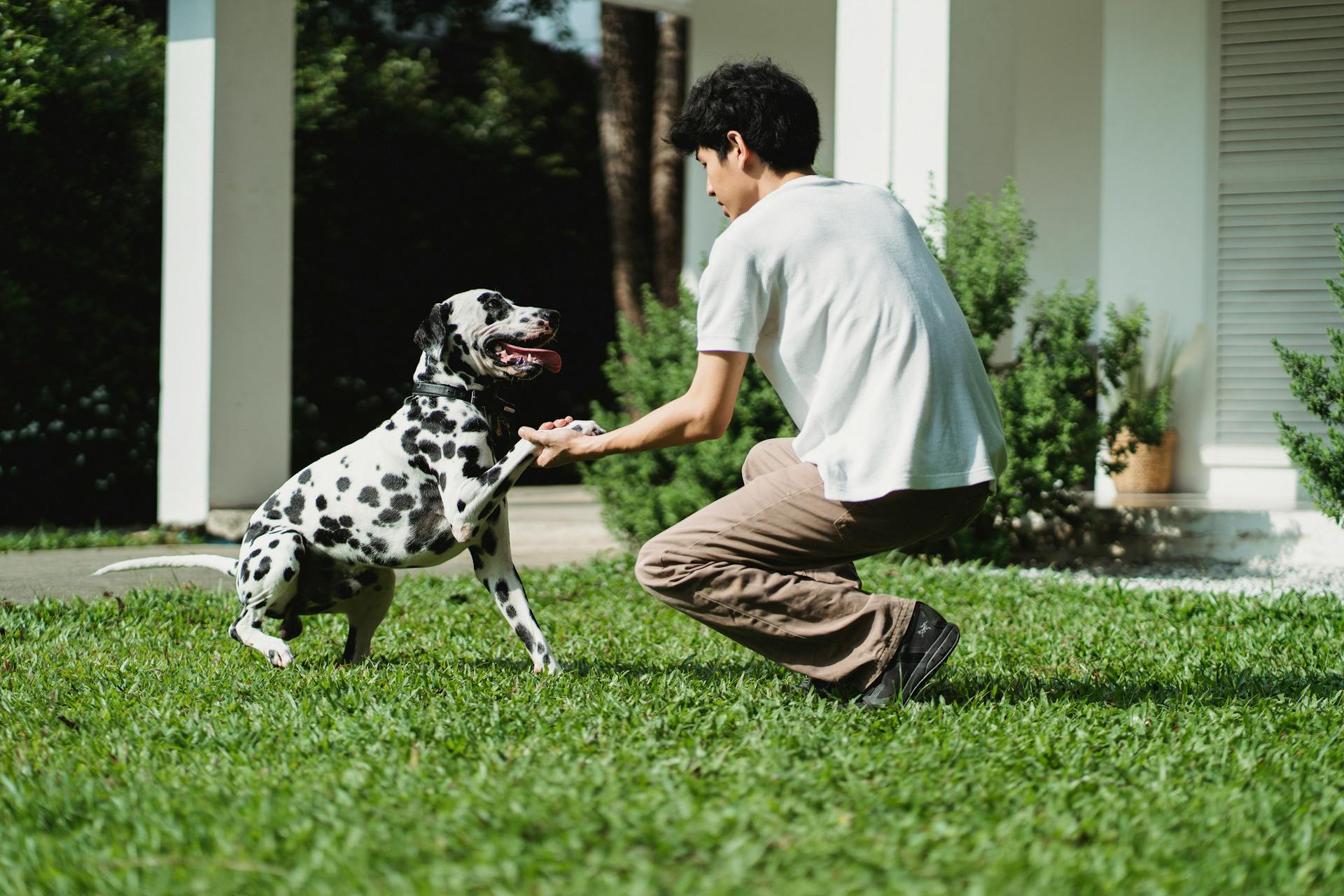
Classical conditioning dog training is a powerful technique that can help you raise a well-behaved and obedient furry friend.
It's based on the principles discovered by Ivan Pavlov, a Russian scientist who found that dogs can associate neutral stimuli with naturally occurring events, like food.
Pavlov's famous experiment involved ringing a bell before presenting food to dogs, which eventually led them to salivate at the sound of the bell alone.
By understanding classical conditioning, you can create positive associations in your dog's mind, making training easier and more effective.
For another approach, see: Training Dog to Ring Bell to Go Out
Key Concepts
A conditioned stimulus is a stimulus that was once neutral but now leads to a response. For example, if you previously didn't pay attention to dogs, but then got bit by one, and now you feel fear every time you see a dog, the dog has become a conditioned stimulus.
Conditioned response is a learned response or a response that is created where no response existed before. This can happen when we associate a neutral stimulus with something unpleasant, like getting bit by a dog.
The fear you experience after being bitten by a dog is a conditioned response. It's a reaction that you've learned to associate with the presence of dogs.
Related reading: Dog Fear Aggression Training
Training Phases
Classical conditioning dog training involves several key phases that help your furry friend learn new behaviors and associate them with positive outcomes.
The first phase is Before Conditioning, where a naturally occurring stimulus automatically elicits a response. For example, a dog's unconditioned stimulus (UCS) might be the smell of food, which naturally triggers a salivation response.
During this phase, a neutral stimulus produces no effect yet. It's only when the neutral stimulus is paired with the UCS that it will come to evoke a response.
Two critical components of this phase are the unconditioned stimulus and the unconditioned response. The unconditioned stimulus is something that unconditionally triggers a response, while the unconditioned response is the natural response that occurs to the unconditioned stimulus.
A neutral stimulus is introduced, and an unconditioned stimulus is paired with an unconditioned response, setting the stage for the next phase.
Here's a breakdown of the Before Conditioning phase:
The second phase is During Conditioning, where the previously neutral stimulus is repeatedly paired with the unconditioned stimulus. This pairing forms an association between the neutral stimulus and the UCS, turning the neutral stimulus into a conditioned stimulus.
As a result, the subject begins to respond to the conditioned stimulus, which is a previously neutral stimulus that now triggers a conditioned response. This phase involves repeatedly pairing a neutral stimulus with an unconditioned stimulus to establish the association.
Acquisition is the initial stage of learning, where a response is first established and gradually strengthened. During this phase, a neutral stimulus is repeatedly paired with an unconditioned stimulus, establishing an association between the two.
Once the response has been established, it can be gradually reinforced to make sure the behavior is well learned. This phase is critical in classical conditioning dog training, as it lays the foundation for future learning and behavior.
If this caught your attention, see: Conditioned Emotional Response Dog Training
Learning Theory
Classical conditioning dog training is based on the principles of learning theory, which helps us understand how dogs learn and behave. The theory explains how dogs can be trained without punishment through humane and ethical methods.
Science-based trainers utilize information from comparative psychology, ethology, animal welfare, and applied behavior analysis to design a training program for your dog's particular needs and behavioral issues. This method is scientifically informed with the latest up-to-date research on effective behavior modification techniques.
Discrimination is the ability to differentiate between a conditioned stimulus and other stimuli that have not been paired with an unconditioned stimulus. This is a key principle of classical conditioning in psychology.
Take a look at this: Operant vs Classical Conditioning Dog Training
Science-Based
Science-Based Training is a humane and ethical approach to dog training that utilizes the latest research on effective behavior modification techniques. This method is scientifically informed and applies learning theory, operant conditioning, and classical conditioning to develop a training program tailored to your dog's needs and behavioral issues.
Science-based dog trainers understand that dogs behave in certain ways due to their perceptions and emotional reactions. By changing these underlying dynamics, you can help your dog change their actions and reactions.
One of the key principles of science-based training is discrimination, which is the ability to differentiate between a conditioned stimulus and other stimuli that have not been paired with an unconditioned stimulus.
Some trainers use negative reinforcement, which can be emotionally and physically damaging to your animal companion. This is why it's essential to work with a science-based trainer who uses well-researched techniques that lead to better outcomes.
- Humane and ethical
- Can help transform moderate to severe behavioral challenges
- Well-researched techniques lead to better outcomes
Science-based training can help you understand why your dog is behaving in a certain way, allowing you to address the underlying issues and develop a deeper appreciation for your canine's perspective of the world.
Spontaneous Recovery
Spontaneous recovery is a fascinating phenomenon where a learned response suddenly reemerges, even after a period of extinction.
This can happen with conditioned responses, such as a dog salivating to the sound of a bell.
Spontaneous recovery is thought to occur when the conditioned stimulus and unconditioned stimulus are no longer associated, allowing the learned response to resurface.
Extinction will likely return very rapidly after a spontaneous recovery, as the conditioned stimulus and unconditioned stimulus are no longer associated.
Take a look at this: No Pull Dog Harness Training
Advanced Training
Classical conditioning training is a powerful tool for modifying your dog's behaviors, and it's surprisingly effective at changing patterns of anxiety or aggression. This natural form of learning can be easily combined with other training methods.
One way to use classical conditioning is by associating a specific stimulus with a reward, like using a clicker to signal when your dog is "spot on" with their training. This helps your dog learn to associate the sound of the clicker with a positive outcome.
Suggestion: Why Use a Clicker for Dog Training
Classical conditioning can also be used to ease anxiety by associating previously scary stimuli with rewards, such as providing a lovely Kong stuffed with peanut butter every time your pup enters the crate. This helps them start associating the crate with a special treat.
- Very effective at changing patterns of anxiety or aggression
- Natural form of learning
- Can be easily combined with other training methods
Model Training
Model training is a powerful method that taps into a dog's social nature to encourage learning. By observing other well-trained dogs, your pup can pick up new skills quickly.
This method is often used in search and rescue training as well as with herding dogs. It has been shown to be as effective as rewards-based training or classical conditioning.
Dogs tend to get very excited with this type of training, often barking their enthusiasm. As long as the barking is coming from excitement rather than anxiety, it actually helps puppers learn faster and more effectively.
Model-rival training avoids extrinsic rewards like food and praise, instead focusing on intrinsic rewards where the task itself becomes the reward. This approach can be especially great for puppies, who can learn complex tasks with ease.
Here are some key benefits and considerations of model-rival training:
- Great for puppies
- Can be used to train complex tasks
- Avoids rewards and punishments and focuses on enthusiasm
However, this method does require other dogs to work with, and enthusiastic barking dogs can be overwhelming for some folks.
Discrimination
Discrimination is a crucial aspect of classical conditioning in dog training. It's the ability of your dog to distinguish between different stimuli and respond accordingly.
For instance, if you're using a bell tone as a conditioned stimulus, your dog needs to be able to tell the difference between the bell tone and other similar sounds. This is known as discrimination.
As an example, if you're using a clicker to train your dog, they need to learn to associate the sound of the clicker with a reward, but not with other noises that might sound similar. This is where discrimination comes in.
Here are the key characteristics of discrimination in classical conditioning:
- Ability to distinguish between different stimuli
- Responding only to the conditioned stimulus
- Not responding to similar but distinct stimuli
Dog Training
Dog training is a fascinating topic, and classical conditioning is a powerful tool in shaping your dog's behavior. Classical conditioning involves associating certain behaviors with particular events, allowing your dog to learn naturally.
This type of learning is based on the associative learning theory, where your dog associates certain behaviors with particular events. Ivan Pavlov's famous experiment with his dog, who salivated at the sound of a bell because it meant food, is a classic example of classical conditioning.
Suggestion: Operant Conditioning Dog Training
Classical conditioning can be used to ease anxiety by associating previously scary stimuli with rewards. For instance, if your pup gets anxious when you crate them, providing a lovely Kong stuffed with peanut butter every time they enter the crate helps them start associating it with a special treat.
Dogs can learn to associate the sound of a clicker with a reward, making it a useful tool in classical conditioning training. The clicker is used to signal when your dog is "spot on" with their training.
Classical conditioning can also be used to teach your dog to overcome fears and control aggression. By associating the feared stimulus with a reward, your dog can learn to feel more comfortable around it.
Here are some key benefits of classical conditioning in dog training:
- Very effective at changing patterns of anxiety or aggression
- Natural form of learning
- Can be easily combined with other training methods
The Final Word
Classical conditioning dog training is a comprehensive method that involves taking care of multiple factors and consistency. This approach helps prevent your dog from feeling overwhelmed.
You don't want your dog to feel overwhelmed, so it's essential to keep the training process simple and straightforward. The process becomes even more critical when the dog already has negative associations with certain things.
Consistency is key in classical conditioning dog training. By following a consistent routine, you can help your dog feel more secure and confident.
Taking care of multiple factors means considering your dog's environment, emotions, and experiences. This includes being mindful of any negative associations your dog may have with certain things or situations.
For another approach, see: Negative Punishment Dog Training
Sources
- https://www.astroloyalty.com/common-dog-training-methods-and-their-pros-and-cons/
- https://www.verywellmind.com/classical-conditioning-2794859
- https://walkandwagchapelhill.com/changing-your-dogs-behavior-using-conditioning-an-introduction/
- https://ridgesidek9.com/pavlovs-theory-of-classical-conditioning-and-dog-training-an-introduction/
- https://blog.smartanimaltraining.com/2014/02/24/classical-conditioning-in-dogs-beyond-the-training-session/
Featured Images: pexels.com


